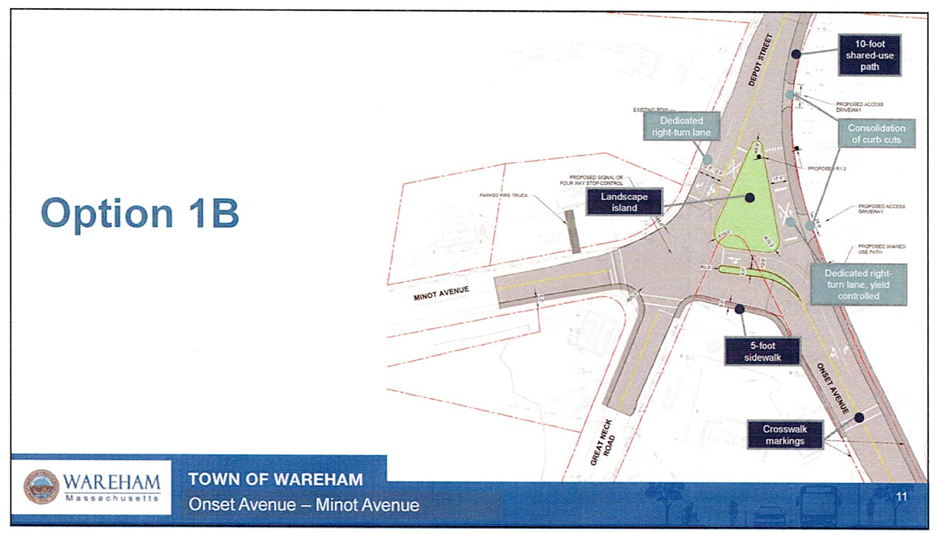The road to improvement for problem Onset Avenue intersection
The intersection outside Onset Village where four roads meet — Onset Avenue, Minot Avenue. Great Neck Road and Depot Street — is a source of confusion for many.
The town is looking at multiple options for how to make that intersection better, including changing it into a standard four-way intersection and installing a roundabout.
Consultants Lisa Juan and Billy Scully of Kimley-Horn presented these options at a public meeting on Wednesday, Nov. 30.
The intersection as it presently exists is an unusual one, said Scully. "Over the years of doing all this kind of stuff, you have what we call T-type intersections, Y-type intersections, but every time I look at this, I go, 'I've never seen an A-type intersection,'" he said.
Depot Street comes in to the top of the A-shaped intersection, and splits into the two legs of the A: Great Neck Road to the west, and Onset Avenue to the east. Minot Avenue enters the intersection from the west, at the middle beam of the A.
It's a dangerous intersection, with a calculated intersection crash rate higher than the average for the area, based on the consultants' research.
The town has five different options to consider for the complex intersection (Depot Street/Great Neck Road at Minot Avenue/Onset Avenue), with several of the options having more than one variation. See accompanying diagrams for examples of the different approaches, and see attached presentation for more details.

The first option turns the intersection into something resembling a typical, 4-way intersection, with the center of the intersection placed on the eastern leg of the "A" Great Neck Road-Depot Street route. The variation (Option 1B) adds a one-way bypass lane for travelers coming from Onset Avenue from the south to Depot Street to the north.

The second and third options place the center of the intersection on the Onset Avenue-Depot Street route, on the western leg of the "A".
The second option includes a bypass lane for travelers coming from Depot Street from the north, allowing for a right-turn movement onto Minot Avenue, as well as (in one variation) a through/right-turn movement onto Minot Avenue or Great Neck Road. The third option eliminates the bypass lane, but keeps the intersection centered on the Onset Avenue-Depot Street route.
The first three options direct traffic through traffic lights or stop signs. The following methods, which are the last two options use a different intersection control, roundabouts.

The fourth option places a roundabout centered on the Great Neck Road-Depot Street route, on the western side of the "A", and includes a bypass lane for travelers going from Onset Avenue onto Depot Street. The fifth does not include a bypass lane, and is like a peanut shaped roundabout.
The consultants planned all of the options around multiple modes of travel.
Pedestrians and bicycles have access to the intersection through dedicated paths, sidewalks and crosswalks. Consultants said the intersection could use pedestrian-activated hazard lights to ensure safety at the crosswalks.
All the options have also been tested for large vehicles such as school buses and tractor trailers. Several designs include "truck aprons," flat areas by the curbs to give the vehicle's back wheels greater clearance, consultants said.
The different options all have pros and cons.
Consultants estimated a cost of $1.2 million for design and construction of the non-roundabout options, and $2.3 million for design and construction of a roundabout. Consultants warned that these cost estimates are very rough projections.
Several residents showed up at the meeting and generally expressed a preference for Option 1B or Option 4, both of which have an Onset Avenue to Depot Street bypass lane.
Shawn McCoy, who owns Depot Liquors at the intersection, expressed concerns about how the redesigns would affect the entrances to his business. He said none of the options presented solved the problems he saw at the intersection.
Even if the town chooses to move forward with the project immediately, and if everything goes smoothly, it would take four to five years for it to be completed, Scully said.











































